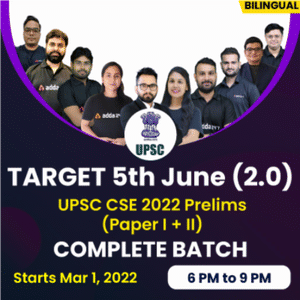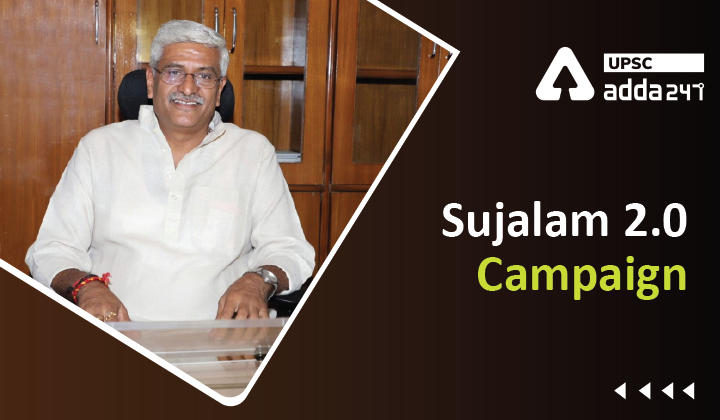Table of Contents
Sujlam 2.0 UPSC: Relevance
- GS 2: Issues relating to development and management of Social Sector/Services relating to Health, Education, Human Resources
Sujlam 2.0: Context
- Recently, Ministry of Jal Shakti has launched Sujlam 2.0 campaign to mark the World Water Day, 2022 for greywater management.
Sujlam 2.0: Key points
- A Joint Advisory was also signed by 9 Ministries on how greywater management will be taken up at their level based on convergence model with all those who are directly associated in programme implementation.
- Under the campaign, the Ministry plans to mobilize communities, institutions like panchayats, schools, anganwadi to undertake greywater management.
- Greywater can be best managed where it is generated and turns into a major management and infrastructure challenge, if it is allowed to accumulate and stagnate.
- PRIs (Panchayati Raj Institutions) would work with people to ensure that greywater is managed at the most appropriate local level through construction of household and community soak pits.
- Funds to execute the activities for greywater management can be sourced from SBM-G Phase II or through 15th Finance Commission tied-grants or MGNREGS or through convergence of all.

Greywater management: Why important?
- It is estimated that 31 billion litres of greywater are generated every day in India.
- With large number of villages achieving 100% saturation under Jal Jeevan Mission, the time has come to focus on management of grey water generated in villages.
- The greywater generated from rural homes has to be managed properly otherwise it poses a big problem.
What is greywater?
- Greywater or sullage is defined as wastewater without faecal contamination.
- Greywater examples: Waste water from showers, baths, basins, and washing machines.
- It is considered high volume, low strength wastewater with high potential for reuse and application.
- The composition of greywater varies from place to place and depends on the lifestyle, fixtures and climatic conditions.
- Reuse of greywater has been an age-old practice, and it is still being done in areas that are water stressed.

Reuse of greywater
- Treated greywater can help reduce the over-reliance on freshwater resources and reduce the pollution caused by discharge of untreated greywater into freshwater resources.
- Greywater can also be a supplementary source to existing water sources in areas where there is acute water crisis or in arid climatic regions.
- Moreover, recycled greywater can be used for different water-demanding activities such as toilet flushing and agriculture and gardening.
Key Points about Sujalam Campaign
- Sujalam Campaign will be a 100 days campaign with an aim to make more villages ODF+ by Undertaking Waste Water Management at Village Level.
- SUJALAM Campaign also aims to create 1 million Soak-pits and also other greywater management activities for making more Villages ODF Pus in an accelerated manner.
- In Nandurbar, a tribal district in Maharashtra, by building a large number of soakpits, they were able to reduce the incidences of malaria, dengue and other water and vector borne diseases apart from environment and ecological benefits.
- Major Sanitation issues in Rural Areas: The disposal of wastewater and clogging of water bodies in the villages or on the outskirts of the villages.
- Expected outcomes of the Sujalam Campaign: will boost the momentum of Swachh Bharat Mission-Gramin (SBMG) phase II activities through community participation and it will increase awareness about ODF-plus activities.
Read current affairs for UPSC
| Women Transforming India Awards (WTI) | Hydrogen-based Advanced Fuel Cell Electric Vehicle | Parliamentary Panel Report on MGNREGA | Colombo Security Conclave (CSC) |
| I-Sprint’21 and InFinity Forum 2021| The Global FinTech Hackathon | India’s Arctic Policy | National eVidhan Application (NeVA) | Indian Standards for Drinking Water | Bureau of Indian Standards (BIS) |
| Sovereign Green Bonds | National Rail Plan Vision 2030 | India Cooling Action Plan | Maternal Mortality Ratio (MMR) Declines | Registrar General of India |
| RBI Releases Regulatory Framework for Microfinance Loans Directions, 2022 | PLFS Quarterly Bulletin April-June 2021 | Global Entrepreneurship Monitor (GEM) Report | Kanya Shiksha Pravesh Utsav Abhiyan |



 TSPSC Group 1 Question Paper 2024, Downl...
TSPSC Group 1 Question Paper 2024, Downl...
 TSPSC Group 1 Answer key 2024 Out, Downl...
TSPSC Group 1 Answer key 2024 Out, Downl...
 UPSC Prelims 2024 Question Paper, Downlo...
UPSC Prelims 2024 Question Paper, Downlo...
